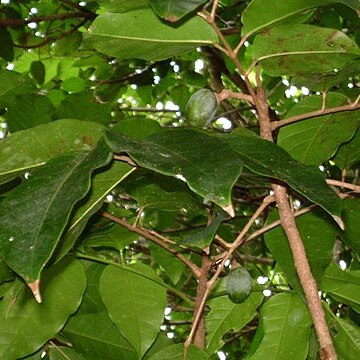Trees, usually dioecious but occasional hermaphrodite flowers may occur. Leaves imparipinnate, with opposite, usually entire, leaflets; stipules present in the Flora species but usually very caducous. Inflorescences long-pedunculate axillary panicles of cymes, the cymules subtended by persistent or caducous bracts. Calyx funnel-, bell-or saucer-shaped, 3-lobed. Petals 3, usually imbricate below and valvate above. Stamens 6, inserted outside or on the edge of the disc, smaller and probably infertile in ♀ flowers. Disc variable, usually a short tube which, when the stamens are attached to its rim, could be taken for the united bases of the filaments. Ovary (absent or vestigial in ♂ flowers) 3-locular, with 2 ovules in each locule; style short; stigma subcapitate, ± 3-lobed Fruit an indehiscent drupe, the fleshy pericarp (composed of the united ectocarp and mesocarp) enclosing a single ± trigonous 3-locular stone (the endocarp) whose sides open like lids when the seeds germinate. Seeds 3 (1 per locule) or fewer by abortion. Cotyledons digitately 3-foliolate or palmatifid, plicate or conduplicate.
Stipules either foliaceous (Fig. 22d & f-i) or pectinate (Fig. 22j-k), enveloping the terminal bud, or small and shrivelled, auricle-shaped (Fig. 22e & Fig. 25), rarely absent; scars mostly linear or, if on the petiole, drop-shaped. Bracts usually consisting of the persistent connate stipules, concave, enveloping the flower buds (Fig. 1a-h), rarely lanceolate to subulate. Leaflets brownish when dry; margin entire to dentate; indument, if present, shortly tomentose. Inflorescences usually terminal, rarely all axillary. Stamens usually free or adnate to the disk, very rarely up to halfway connate. ♀ Flowers nearly always with a concave receptacle; in that case disk adnate to the receptacle and pistil stalked; disk and pistil usually glabrous. Calyx in fruit rarely less than 1 cm diam., usually flat with undulate margin, or more or less funnel-shaped, often densely tomentose. Fruits rather large, usually 5-7 cm long; pyrene smooth, sometimes with angle-and median ribs.
Stipules subulate to lanceolate, not rarely absent; scars orbicular, minute. Bracts deltoid to subulate, not consisting of connate stipules (Fig. 1i-j). Leaflets greyish-green when dry; margin entire to serrate; indument, if present, mostly consisting of hispid hairs. Inflorescences mostly axillary to pseudoterminal, very rarely terminal. Stamens often partly to entirely connate, rarely adnate to the disk. Receptacle in female flowers nearly always flat, very rarely slightly concave. Disk usually 6-lobed, often pilose. Pistil very rarely stalked, mostly pilose. Calyx in fruit rarely more than 1 cm diam., outside usually glabrous, inside mostly sericeous, flat, lobes often reflexed. Fruits small, 2½-3½(-5) cm long; pyrene often with angle-and median ribs, sometimes entirely tuberculate.
Trees evergreen. Branchlet pith usually with vascular strands. Leaves alternate, odd-pinnate, stipulate or exstipulate. Flowers in terminal or axillary panicles, unisexual. Calyx cupular or campanulate, 3-lobed or-fid, valvate. Petals 3, imbricate below or valvate, usually exceeding calyx. Stamens 6, free to connate, inserted on margin or outside of disk. Ovary 2-or 3-celled; ovules 2 in each cell; style short to long; stigma capitate. Drupe usually ellipsoid, ± distinctly trigonous, with a 1-3-celled, 1-3-seeded pyrene; cotyledons often partite, contortuplicate.
Trees or shrubs, evergreen or deciduous, dioecious. Leaves mostly compound, usually stipulate. Inflorescence an axillary or terminal panicle, cyme, raceme or spike. Flowers 3-partite. Sepals usually fused basally. Petals usually imbricate. Stamens 6, free or connate, sometimes epipetalous, sometimes adnate to disc, sterile and reduced in female flowers. Disc intrastaminal, usually 6-lobed, well-developed in male flowers. Drupe with a 3-locular stony pyrene.
Stamens 6, free or connate below, inserted on or outside the disk or sometimes, in male flowers, inserted on the disk which then resembles an androphore, smaller and infertile in female flowers.
Inflorescences of axillary paniculate cymes, peduncle usually elongated; cymules surrounded by persistent or caducous bracts.
Ovary (absent or vestigial in male flowers) 3-locular, loculi 2-ovulate; style ± elongated; stigma subcapitate, ± 3-lobed.
Fruit a drupe; pericarp fleshy; endocarp crustaceous, ± trigonous, 3-locular with 3 seeds or 2 loculi sometimes abortive.
Seed with 3-foliolate or palmatifid, plicate or conduplicate cotyledons.
Leaves imparipinnate, leaflets in up to c. 24 pairs, usually entire.
Petals 3, usually imbricate below but valvate towards the apex.
Calyx infundibuliform, campanulate or saucer-shaped, lobes 3.
Disk variable in form, sometimes pubescent.
Flowers unisexual.
Dioecious trees.

